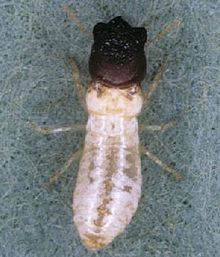用户:Kevin88lue/沙盒
| 这是Kevin88lue的用户沙盒。用户沙盒是用户页的子页面,属于用户的测试区,不是维基百科条目。 公用沙盒:主沙盒 | 使用指南沙盒一、二 | 模板沙盒 | 更多…… 此用户沙盒的子页面: 外观选项: 用字选项: 如果您已经完成草稿,可以请求志愿者协助将其移动到条目空间。 |
| Kalotermitidae | ||||||||||||
|---|---|---|---|---|---|---|---|---|---|---|---|---|
 | ||||||||||||
| 科学分类 | ||||||||||||
| ||||||||||||
| Genus | ||||||||||||
|
木白蚁科 (Kalotermitidae) 是白蚁的一个类群,俗名“干木白蚁”。木白蚁科有21属419种,分布于干燥气候的环热带地区。
生态
[编辑]木白蚁科形态、筑巢行为和社会行为都较为原始。和其他白蚁不同,木白蚁科不需要接触土壤也能存活,他们取食木头并居住在其中[1],巢体结构简易[2]。
干木白蚁有特化的储水机制。食物经过后肠时,后肠末端特化的腺体会从粪便中吸收水分,因此木白蚁能在干燥的环境中存活,仅倚靠食物提供水分。木白蚁科的大颚含有锌,可以更容易地取食坚硬的干木[3]。
木白蚁科取食干木的习性使他们有能力成为经济和都市害虫,他们能取食家具、电线杆、仓储木材和建筑物。漂流木和国际木材贸易有利于干木白蚁扩散[4]。Cryptotermes brevis 在美国是严重的害虫,分布于夏威夷、佛罗里达州及东南海岸。
繁殖
[编辑]木白蚁科和其他白蚁一样都是真社会性昆虫,但是木白蚁科的阶级发育比较弹性[2][5],而且它们没有真工蚁 (true workers),只有假工蚁 (pseudogates),假工蚁可以继续发育成兵蚁或繁殖型[6]。假工蚁得以存在于木白蚁科中是因为白蚁为不完全变态昆虫 (hemimetabolous),它们没有蛹这个阶段来明确地画分未成熟的“幼虫”与成熟的“成虫”,它们只是暂时担任“工蚁”阶级。从外型上看,假工蚁没有翅芽 (wing buds),而未成熟的“若虫(未发育成熟的有翅型)”则具有翅芽[5]。
有翅繁殖型会在气温 27 至 38°C 的暖和晴天分飞,它们会离开木头并朝四面八方飞去。它们会被光吸引,会聚集在灯光附近,Cryptotermes brevis 会特别偏好波长 460 和 550 nm 的光[7]。落地以后,它们四处摩擦把翅膀弄断,繁殖型会成双成对地筑巢[8]。
系统分类学
[编辑]木白蚁科为低等白蚁 (lower termites),低等白蚁为非正式的分类方式,肠道中除了细菌外还有共生原生动物的白蚁称作低等白蚁,而没有原生动物的白蚁称作高等白蚁[9]。除了白蚁科外,其他白蚁都是低等白蚁[10]。近期支序学研究支持木白蚁科为单系群[9][11]。
木白蚁科中属上无更高级的分类阶层[4],属与属之间的关系研究甚少,尚未明了[2]。有限的分子生物学证据支持木白蚁属 (Kalotermes ) 为木白蚁科的基群,因此木白蚁科有两条主要分支,在木白蚁属的分支上,木白蚁属和角木白蚁属 (Ceratokalotermes ) 为姊妹群,然而,这与先前依照形态做的支序树相悖[2]。
属
[编辑]参考文献
[编辑]- ^ Arnett, Ross H. 2000. American Insects: A Handbook of the Insects of America North of Mexico. CRC Press. 2nd Edition.
- ^ 2.0 2.1 2.2 2.3 Thompson, G. J.; Miller, L. R.; Lenz, M.; Crozier, R. H. Phylogenetic analysis and trait evolution in Australian lineages of drywood termites (Isoptera, Kalotermitidae). Molecular Phylogenetics and Evolution. December 2000, 17 (3): 419–429. PMID 11133196. doi:10.1006/mpev.2000.0852.
- ^ Nalepa, C. A. Origin of termite eusociality: trophallaxis integrates the social, nutritional, and microbial environments. Ecological Entomology. August 2015, 40 (4): 323–335. doi:10.1111/een.12197.
- ^ 4.0 4.1 Abe T, Bignell DE, and Higashi M. 2000. Termites: Evolution, Sociality, Symbioses, Ecology. Kluwer Academic Publishers.
- ^ 5.0 5.1 Noiot C. 1985. Pathways of Caste Development in the Lower Termites in "Caste Determination in Social Insects."
- ^ "Termite Larvae Info"
- ^ Ferreira, M.T.; Borges, P.A.; Scheffrahn, R.H. Attraction of alates of Cryptotermes brevis (Isoptera: Kalotermitidae) to different light wavelengths in South Florida and the Azores. Journal of Economic Entomology. December 2012, 105 (6): 2213–2215. PMID 23356089. doi:10.1603/EC12240
 .
.
- ^ Scheffrahn, R.H.; Su N. West Indian drywood termite, Cryptotermes brevis (Walker) (Insecta: Isoptera: Kalotermitidae) (报告). IFAS Extension. EENY079. University of Florida. 1999.
- ^ 9.0 9.1 Inward DJ, Vogler AP, and Eggleton P. 2007. A comprehensive phylogenetic analysis of termites (Isoptera) illuminates key aspects of their evolutionary biology.
- ^ Korb, J.; Hartfelder, K. Life history and development – a framework for understanding developmental plasticity in lower termites. Biological Reviews. August 2008, 83 (3): 295–313. PMID 18979593. doi:10.1111/j.1469-185X.2008.00044.x.
- ^ Legendre, F; Whiting, MF; Bordereau, C; Cancello, EM; Evans, TA; Grandcolas, P. The phylogeny of termites (Dictyoptera: Isoptera) based on mitochondrial and nuclear markers: Implications for the evolution of the worker and pseudergate castes, and foraging behaviors. Molecular Phylogenetics and Evolution. August 2008, 48 (2): 615–627. PMID 18502666. doi:10.1016/j.ympev.2008.04.017.
外部链接
[编辑]- Description of an early Cretaceous termite (Isoptera: Kalotermitidae) and its associated intestinal protozoa, with comments on their co-evolution.
- Drywood Termite (Kalotermitidae) Fact Sheet from the National Pest Management Association with information on habits, habitat and prevention
- Kalotermitidae on BugGuide.net
- Kalotermitidae on the Tree of Life web project

